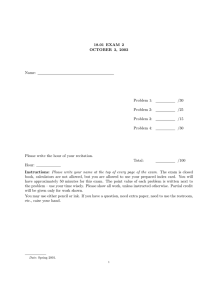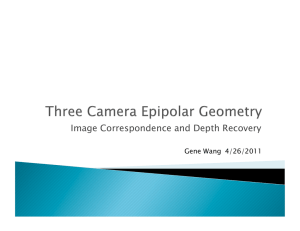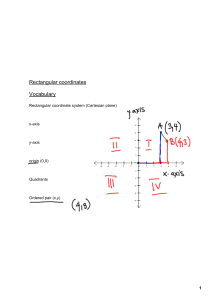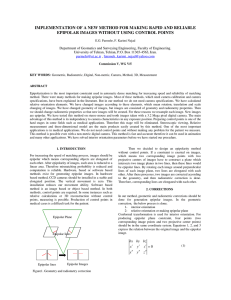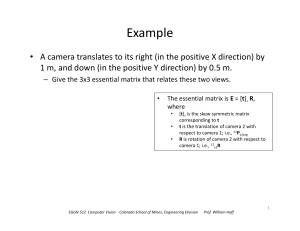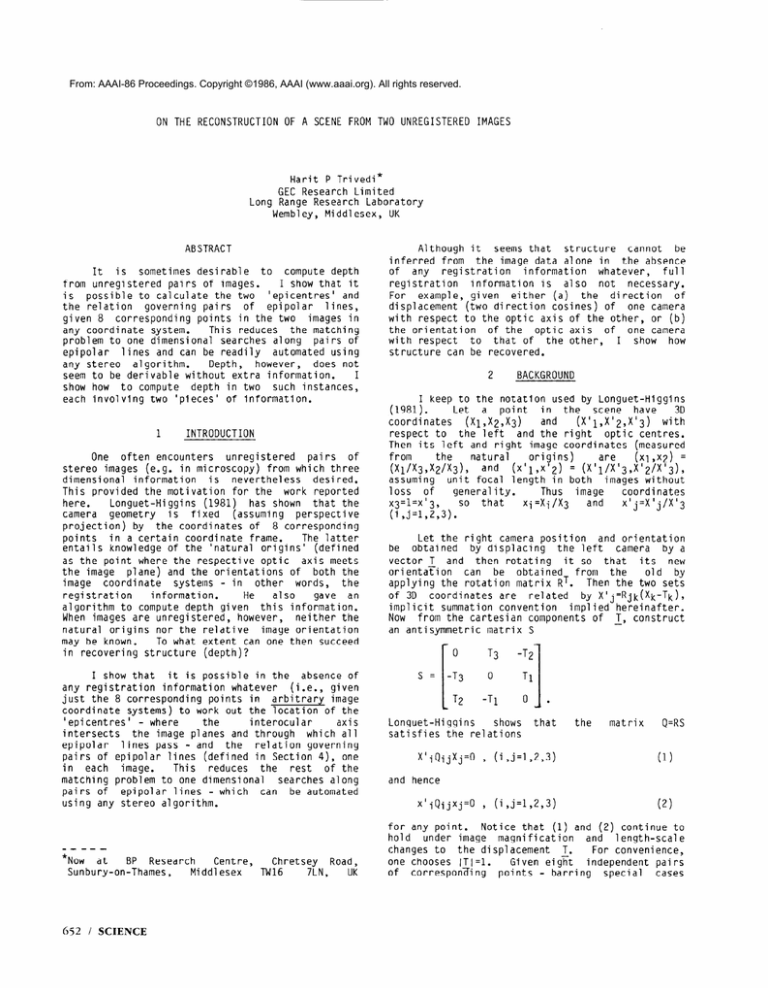
From: AAAI-86 Proceedings. Copyright ©1986, AAAI (www.aaai.org). All rights reserved.
ON THE RECONSTRUCTION
OF A SCENE
FROM TWO UNREGISTERED IMAGES
Harit P Trivedi*
GEC Research Limited
Long Range Research Laboratory
Wembley, Middlesex,
UK
ABSTRACT
It is sometimes desirable
to
compute depth
I show that it
from unregistered
pairs of images.
is
possible to calculate the two
'epicentres' and
the relation
governing pairs
of
epipolar
lines,
points in the two
images in
given 8 corresponding
This reduces
the matching
any coordinate
system.
problem to one dimensional
searches along
pairs of
epipolar
lines and can be readily
automated using
however,
does not
algorithm.
Depth,
any stereo
seem to be derivable without extra information.
I
depth in two
such instances,
show how
to compute
each involving two 'pieces' of information.
Although it
seems that
structure
cannot
be
inferred from
the image data alone in the absence
registration
of any
information
whatever,
full
information
is also
registration
not
necessary.
For
example, given
either (a) the
direction
of
displacement
(two direction cosines) of one camera
with respect to the optic axis of the other, or (b)
the orientation
of the
optic axis
of one camera
with respect
to
that of the other,
I show how
structure can be recovered.
2
BACKGROUND
I keep to the notation used by Longuet-Higgins
Let
a point
in the
scene
have
3D
(X'I,X'2,X'3)
with
coordinates
(xl&&)
and
respect to the left
and the right
optic centres.
Then its left and right image coordinates
(measured
from
the
natural
origins)
are
(x1,x2) =
(x’l ,x12) = (x’l/x’3,x’2/x’3),
(x1/x3&‘&),
and
assuming
unit focal length in both
images without
loss
of
generality.
Thus
image
coordinates
x3=1=x13,
so that
Xi=Xi/X3
and
X'j=X'j/X'3
(i,j=1,2,3).
(1981).
1
INTRODUCTION
One
often encounters
unregistered
pairs
of
from which three
stereo images (e.g. in microscopy)
dimensional
information
is nevertheless
desired.
This provided the motivation
for the
work reported
here.
Longuet-Higgins
(1981)
has shown
that the
camera
geometry
is fixed
(assuming
perspective
projection)
by the coordinates
of 8 corresponding
points
in a certain coordinate
frame.
The latter
entails knowledge of the 'natural origins' (defined
as the point where the respective optic
axis meets
the image
plane) and the orientations
of both the
image
coordinate
systems - in other
words,
the
information.
also
gave
an
registration
He
algorithm to compute depth given
this information.
When images are unregistered,
however,
neither the
natural origins nor the relative
image orientation
may be known.
To what extent can one then succeed
in recovering structure
(depth)?
I show that
it is possible in the
absence of
any registration
information whatever
(i.e., given
just the 8 corresponding
points in arbitrary
image
coordinate
systems) to work out the location of the
'epicentres'
- where
the
interocular
axis
intersects
the image planes and through
which all
epipolar
lines pass - and
the
relation governing
pairs of epipolar lines (defined in Section 4), one
in each
image.
This
reduces
the
rest
of the
matching problem to one dimensional
searches along
pairs of
epipolar lines - which
can
be automated
using any stereo algorithm.
a----
*Now
at
BP Research
Centre,
Sunbury-on-Thames,
Middlesex
652
/ SCIENCE
Chretsey
Road,
TW16
7LN,
UK
Let the right camera position
and orientation
be obtained
by displacing
the left
camera
by a
vector T and
then rotating
it so that
its
new
orientarion
can
be obtained
from
the
old
by
applying the rotation matrix RT.
Then the two sets
of 3D coordinates
are
related
by X'j=Rjk(Xk-Tk),
implicit summation convention
implied hereinafter.
Now
from the Cartesian components
of 1, construct
an antisymmetric
matrix S
Longuet-Higgins
shows
satisfies the relations
X'iQijXj=O
that
the
matrix
Q=RS
, (i,j=1,2,3)
(1)
, (i,j=1,2,3)
(2)
and hence
X'iQijxj=O
for any point.
Notice that (1) and (2) continue to
hold
under image
magnification
and
length-scale
changes to
the displacement
T.
For convenience,
one chooses lTl=l.
Given eight
independent
pairs
of correspon?Ting
points - barring
special
cases
(1984))
-,
it
is
Longuet-Higgins
(see
straightforward
to compute the 8 independent
ratios
to an 8 by 8
of the
elements of Q as solutions
In the
linear simultaneous
system of equations.
also
shows
how
to
Longuet-Higgins
same
paper,
extract R and T (from Q), and hence structure.
3
TRANSFORMATION
UNDER
ROTATION
(x' )TQ x=0;
(3)
i .e.,
(RZ'(dx')T(R,'(g)Q)
see
we
immediately
satisfies an equation
Q +Q'=Rz'
x=0,
that
the
image
pair
still
of the form (2) but with
to get things
in R, i.e.,
right
(g).Rl.
is to
(6)
Next we consider the effect of displacing
the
origins by (uI,u2) and (u'I,u'2) in the left
right
images
respectively.
Then
the
and
x'j + E'j=x' *-u'j,
(i,j=1,2,3;
Xi
+ C’Xi’Ui,
($) yields,
after
u3=u3'=0).
Starting
with
algebraic manipulation,
the relation
image
and
c'iQ"ijcj=O,
or,
(c ')TQ"k
>=O;
(7)
where
(74
u3=O=u'3,
Q"ij=Qij,
(i,j=1,2)
(7b)
Q" lj=Qn+r,
(7c)
Q”23=Q23=s,
(7d)
Q"31 =Q31 +r ' ,
(74
Qi’32=Q32+s ' ,
Uf)
Q"33=Q33+to+tlo+v;
(79)
i.e.,
Q +Q"=
till
412
Q13+r
421
Q22
Q23+s
Q31+r'
Q32+s'
Q33+to+t'o+vJ
1
(8)
l
Q21
Q22
(gb)
Pa)
3
m>
t’o=u’l.Q13+u’2-Q23,
(W
v=r'.uI+s' .u2=u'I.r+u'2.s.
(94
and
Combined
rotations
and translations
of the image
coordinate
systems
can be
readily
described
by
replacing Q in
(7)-(g) with Q' of (5).
The image
coordinates,
therefore,
always obey a
relation of
or equivalently,
(3), whatever the
the
form (2),
coordinate
system.
Using this observation,
I show
how to work out the locations of the epicentres and
the relation governing pairs of epipolar lines.
EPICENTRES
AND EPIPOLAR
LINES
Where
the
interocular
axis
intersects
the
image planes are the two epicentres.
Now imagine a
family of planes passing
through
the interocular
axis.
Each such plane intersects each image plane
in a straight line (which naturally
passes through
the respective epicentre),
giving rise to
pairs of
epipolar
lines.
Let the
left
and
the
right
epicentres be lotted at (~I,7c2) and (~'I,n'2).
The
equation
of
a straight
line of
slope
m passing
Similarly,
through
(nI,n2) is
(52-n2)=m(cI-nI).
denoting
by m'
the slope
of the
corresponding
epipolar
line,
the
equation
of the
latter
is
[The geometric
motivation
(c'2-n12)=m'(<'I-7+).
presented here
is not essential.
One can
simply
postulate the existence of epicentres
and epipolar
lines and the arguments go through.]
Now any point
on a certain
epipolar line in one image
can match
any point on the corresponding
epipolar line in the
other image.
Given that
all matched
points obey
by inserting for <'2 and c2 from
into
the
matrix
above
representation
of (7), that
=o
(10)
The left hand side
for all
values of 51 and F'I.
is a second
order inhomogeneous
polynomial
in 51
and E'1 and
can vanish identically
if and
only if
the coefficient
of each term vanishes.
This yields
four equations.
The first
of them,
arising from
the vanishing
coefficient
of the
(c'I)(<I) term,
immediately
gives the relation
m=-(Q"II+m1.Q"21)/(Q"12+m'
Here
I
to=Q31q+Q3pq,
4
(5)
(s>Q.
All that needs to be done
absorb the extra rotation
R +&I
(4)
Q12
i
AND TRANSLATION
Now
consider a rotation of the
right image
(described by the rotation matrix RZ'(g)) about its
angle
'g' as
axis -the z' axis - by some
optic
introducing
registration
error in the orientation.
By writing (2) as a matrix equation
[ r’s’I=Cu’1u’21Qll
l
Q"22)
(11)
governing the
slopes of a pair of epipolar lines.
Note that it is independent
of the normalisation
of
The
solution
to the
rest of the
matching
Q" .
PERCEPTION
AND ROBOTICS
/ 653
problem can be mechanised
algorithm.
by the use of any stereo
The condition that the coefficient
of the term
in 5'1 must vanish yields, after
substituting
(11)
in m' which
must
vanish.
for
m,
a polynomial
of m' to
Equating the
coefficient
of each power
zero gives
two linear
inhomogeneous
equations
in
the two unknowns ~c1 and 712:
Q"ij=Qij,
(i.j=1,2)
Q’3i=(U’l-P’l)Qli+(U12_p12)Q2i)
5
Similarly,
the
condition that
the term in c1 vanish yields
the
coefficient
of
WlP’21
= c-Q"31
-Q"321.
(13)
That
the
constant
term
also
vanishes
can
be
verified
by inserting
the coordinates
of the two
epicentres
in (7) and using (12) and (13).
In the
process,
one
obtains
two
interesting
equations
- one for each epicentre:
[n ‘1,
71:‘2,
llQ”=O,
(14)
and
Q"[nl,
implying
det
712, llT=O;
(15)
SCENE
(i=W)
(17)
RECONSTRUCTION
Longuet-Higgins
gives a method
of recovering
structure
from
Q.
He also
points
out
three
equations
relating
the
diagonal
and
the
off-diagonal
elements of the matrix QTQ
(his eqn.
the rotation
matrix dropping
out
in the
(17))s
process.
Three
equations
are not
sufficient to
determine
the
four
unknowns
u1,u2,u'1
and
u'2
needed to recover
Q from (8) or (17).
Thus given
Q" alone, it does not
seem possible to
recover Q
(whence structure).
It is possible to recover
structure,
however,
given
either (a) the direction of displacement
of
one camera with
respect to the optic axis
of the
other, or, (b) the orientation
of the optic axis of
one camera with respect to that of the other.
Note
that Qij=Q"ij,
From
the
image data,
(i,j=1,2).
therefore,
one
can obtain
three
ratios
between
these four elements.
Now, from Q=RS,
that
lQ"l=O.
(16)
This serves as a check
and the calculations.
on the accuracy
of
the data
Q21=T2.R23-T3.R22,
and Q22=T3.R21-Tl.R23.
(i,j,k
a cyclic
Given
R,
and
using
EiX%=Ek,
permutation
of
1,2,3), where FJ,,refers to the mth
row of R regarded as a vector, (18) yields
Alternatively,
observing that the last row and
column of Q" in (8) are linear combinations
of the
rows and
columns
of Q,
it is readily
seen that
detlQ"l=O
if and only if detlQl=O.
That detlQl=O
follows
from the
fact
that detlQl=detlRl.detlSl,
and it can be verified that detlSl=O.
(14)
i.e.,
Starting with (3) and using
and (15) in the 'natural'
[p'1,
~‘2,
llQ=O
the equivalents
of
coordinate
system,
(14&
and
where
epicentres
in
(~1~~2) and (~'1,~'2) are the
the natural coordinate
system, an alternative
form
of Q" can also be given:
=(R13.Q22-R23=Q12)/R32.
The
two
expressions
for
T3 in
(19)
provide
an
accuracy check.
More importantly,
it can
happen
that the
right image
(say) was rotated
about its
original position.
This corresponds
to an unknown
rotation
about
the
z'
axis - represented
by
The two
expressions
W(g)
- g being the angle.
for T3 then
force a constraint on tan(g).
To see
this, write the final rotation matrix as
R + Rz'(d.R,
where
R is
That is,
65-i
/ SCIENCE
(19)
known
(for
example,
(Arfken
1970)).
Equating the
substituting
two expressions
for T3 in
(19) and
for the new R from (20), one obtains
tan(g)=-a/b,
&
X3
=&k
,
(i,j,k being a cyclic permutation
of
1,2,3), where
I&,,refers to the mth
row of R regarded as a vector,
gives
where
aI+bI+fI(aI)+f2(bI)=O
a=(R13.Q21-R23=Q11)/R31
- (R13~Q22-R23~Q12)/R32,
.
(27)
Since fI(aI) and f2(bI) are linear functions
and bI respectively,
(27) takes the form
and
of aI
b=(R23.Q21+R13.Qll)/R31
- (R23~Q22+R13.Q12)/R32.
Wa)
or,
There
are two possible solutions for
g given
If the two images are coarsely aligned (by
tan (9).
is the
say)
then the
small angle
solution
eye,
desired solution.
is a linear
function
of bI.
2
c1=T3p
@a>
-
c2=(T2+ax.Tl)(T
(22)
C3=(T2+ax+(T
Similarly, denoting
is a linear
function of aI.
the
ratio Q22/Q21
by ay
(measured),
and setting
R2I/R22=bI
and R23/R22=b2 it can be verified that
b2=T3.(bI+ay)/(TI+ay.T2)=f2(bI)
(28)
where
Next consider
known
displacement
(TI,T2,T3).
Denoting
the ratio
QII/QI2 by a,
(computed from
RI2/RII=aI
and
data
measurement),
and
setting
it can be readily shown that
RdRll=a2,
a2=T3.(al+ax)/(T2+ax.T1)=flo
bI=(c4-c2.aI)/(c3+cI.aI);
+a .T )+a .T2,
Iy2
x3
(28b)
(28~)
(28d)
c4=-ax.ay. T$
There is now the last piece of unused information,
the ratio Q22/Q12=ayx
(measured).
Writing this out
it [to
get
rid
of the
explicitly,
squaring
square-roots
from
(24)
and
(25)],
and
using
(22)-(28), one
obtains a fourth
degree polynomial
equation in al:
Then
imply
(+Cafx.hl.h2-h3.h4]
(24)
and
+(a$a~x.
The rotation matrix
unknowns RlI,R22,aI
+a .T )+a T2,
y
2
y'3
and
(23)
2
2
2 -1 and R:l+Rg2+RE3=1
Rll+R12+R13'
R;2=l/(l+b:+f;(bl)).
1
(el.h2+hl.e2)-(e
3
.h th
4 3*e4)'
(25)
R is characterised
by the
and bI, and has the form
four
(29)
where
nI=a,.n2,
n2=T3/(T2+axJl),
and
Every
relationship
following
from the equation
PERCEPTION
AND ROBOTICS
i 655
n3=ay.n4,
nq=T3/(Tl+ay.T2);
(29a)
X3=L-(&-x'1~3).J
dI=(T3-TI.nI)2,
d2=(l+ng).c$+2.n
X1=(X1)(X3),
3
.n .c
4
X2=&)(X3),
X'j=Rjk(Xk-Tk).
c +(l+ng).c$,
3’4
(i,j,k
Note that x,ll',X,X'
-coordinate
system.
d3=(l+ni),
dq<(T3-TI.nJ).cJ-n3.c3.TI12;
e2=2.[(l+ng).c
(30)
and
range
(31)
over
1,2,3)
are now in the natural
6
(29b)
(32)
image
SUMMARY
Given 8 corresponding
points
in two
images
without any registration
information whatsoever,
it
is possible to calculate the two epicentres
and the
relation governing
the pairs
of epipolar
lines.
The rest
of the
matching problem
reduces
to one
dimensional
searches
along the epipolar
lines and
can
be
automated
using
stereo
matching
any
algorithm.
eI=-2.TI.n2.(T3-TI.nI),
'C2mC4.
/ ml-x'1&3).~1,
1' c 3+n 3*n4*(c1*c4-c2*c3)
(l+n2,)1
e3=2.nI.n2,
eq=-2[(T3-TI.n4).c4-n3.c3.TI].[cI.n3.TI
+q.(TyTpq)l;
(W
hl=(Tpd2,
h2=(l+ng).c:-2.c
l.c2.n3.n4+(l+ng).c;
,
Although it would appear that structure cannot
be
inferred
from
the
image data
alone
in the
absence
of any registration
information
whatever,
full
registration
information
is
also
not
necessary.
For
example,
given
either
(a) the
direction
of displacement
of one
camera
with
respect to the optic axis of the other, or, (b) the
orientation
of the optic
axis of one
camera with
respect
to that
of the
other,
methods
were
described to obtain structure.
h3=(l+ng),
ACKNOWLEDGEMENTS
and
It is a pleasure to thank Bernard
his critical reading of the manuscript.
hq<cI.n3.TI+c2.(Tg-Tl.n4)12.
Given 1 it is thus possible to compute R, and vice
versa.
Hence Q can also be computed.
From (8) or
re:caling Q", the
unknown coordinates
(171, after
~'2) of the natural
origins can
!:8; ~~)o~~~ir!~d"
The image
coordinates
can then
be appropriateli
transformed
into
their
natural
systems,
whence depth
can be calculated
by the
method prescribed by Longuet-Higgins:
I SCIENCE
for
(294
Efficient
subroutines
exist
(e.g.
NAG)
for
obtaining the four roots of the polynomial.
Having
obtained
al, R can be calculated
using (22)-(26)
and (28).
Since R is real, only real roots are of
interest.
Of the
real roots,
only those
which
depth (both
X3 and X'3>0)
for all
yield positive
points are acceptable.
Empirically,
the polynomial
always appears
to have two real roots.
Each root
has a single
combination
of the signs of RII and
R22
which
yields
positive
depth
for
all
data
nonveridical
points.
The
solution,
however,
produces a large origin shift (typically five times
the image
width) in one image,
and
small depths
(typically
a
few tenths
of
the
interocular
distance).
If the positions of the natural origins
are known even roughly (e.g., they may be known to
lie somewhere
within the pictures),
the veridical
solution can be chosen quite unambiguously.
656
Buxton
REFERENCES
Cl1
Longuet-Higgins,
H.C.
for
reconstructing
projections".
Nature,
VI
Longuet-Higgins,
H.C.
"The reconstruction
of
a scene from
two projections
- configurations
that
defeat
the 8-point
alsorithm"
In the
Proceedings
of
the
First
InternConference
on the Applications
of Artificial
Intelligence.
Denver, Colorado,
USA, (1984)
pp. 395-397
L31
Arfken,
L-41
The
NAG (Numerical
Library, subroutine
G.
"A computer
algorithm
a
scene
from
two
133-5.
293 (1981)
Mathematical
Algorithms
C02AEF.
methods
Group)
for
Fortran

